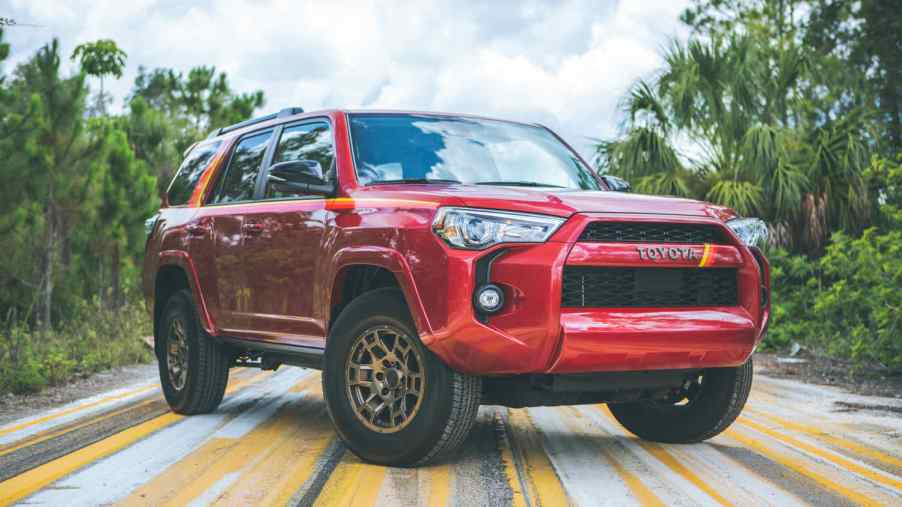
2023 Toyota 4Runner: How Much Does Adding Four-Wheel Drive Cost?
The 2023 Toyota 4Runner is one capable SUV. It has rugged capability due to its body-on-frame construction. The tried and true V6 engine provides reliable power in challenging conditions. And when equipped with four-wheel drive, the Toyota sport-utility can go almost anywhere.
But not all 4Runner trims come with four-wheel drive. And 4WD is almost a necessity for SUV buyers who want to get out and explore. Let’s take a look at the 2023 4Runner, and why 4WD is vital to its performance.
2023 Toyota 4Runner: an SUV made for adventure
With SUVs growing in popularity, they’ve grown more civilized over the years. No longer the truck-based designs of the past, today’s sport utilities often feature car-like unibody construction. While that provides a smooth ride and solid handling, it takes away from off-road chops.
But the Toyota 4Runner sticks to its roots with a body-on-frame build. That’s central to its adventure-minded personality.
For 2023, Toyota offers the 4Runner in eight trims: SR5 ($40,155), TRD Sport ($43,015), SR5 Premium ($43,215), TRD Off-Road ($44,000), TRD Off-Road Premium ($46,580), 40th Anniversary Special Edition ($47,720), Limited ($49,390), and TRD Pro ($54,620).
The SR5, TRD Sport, SR5 Premium, and Limited come standard with rear-wheel drive. Opting for four-wheel drive adds $1,875. While that isn’t cheap, it greatly expands the 4Runner’s capability.
With 4WD, snowy roads or muddy trails aren’t obstacles, they’re opportunities to explore. And knowing your 4Runner can handle any condition brings peace of mind.
But for people set on four-wheel drive, other trims may be a better bet.
The TRD Off-Road brings standard 4WD with a reasonable MSRP. And opting for the TRD Off-Road premium has that and more, with additions like a heated steering wheel, premium audio, and a HomeLink transceiver.
Toyota’s 40th Anniversary 4Runner has motorsport-inspired flair, with red/orange/yellow decals, bronze wheels, and unique interior details. While it costs a little more, its one-of-a-kind build seems worth the price.
Or, for all-terrain excellence, the 4Runner TRD Pro comes loaded with high-end hardware. TRD FOX high-performance shocks and TRD-tuned springs can handle any terrain, from dusty deserts to rocky trails and everything in between.
2023 Toyota 4Runner: why four-wheel drive is essential
A Toyota 4Runner needs 4WD to perform to its potential. Here’s why.
Imagine encountering a snowstorm in a rear-wheel drive 4Runner. All of a sudden, the legendary SUV can’t endure challenging conditions, the rear wheels providing meager traction in snow and ice. It’s like an athlete without proper footwear.
Or, if you want to go off-road, camp out, and get away from it all, a 2WD 4Runner doesn’t provide much reassurance. Sure, in dry conditions it might make it across smooth trails. But what if it rains or ruts appear? Even with its burly construction, the 4Runner has limited range without 4WD.
Without 4WD, the 4Runner becomes a more standard SUV. Otherwise, why not purchase a unibody sport utility for cruising streets and highways?
Since its introduction in 1983, the Toyota 4Runner’s been a tough, reliable sport utility vehicle. With its truck-like body-on-frame construction, the Japanese SUV can handle rutted-out trails and city streets alike. And since it’s a Toyota, drivers know it’s good for the long haul.
But without four-wheel drive, it can’t live up to its storied nameplate. That’s why opting for it on lower trims—or choosing a model with standard 4WD—ensures you get a 4Runner that can go anywhere. For drivers who like to explore, that’s a winning combo.



